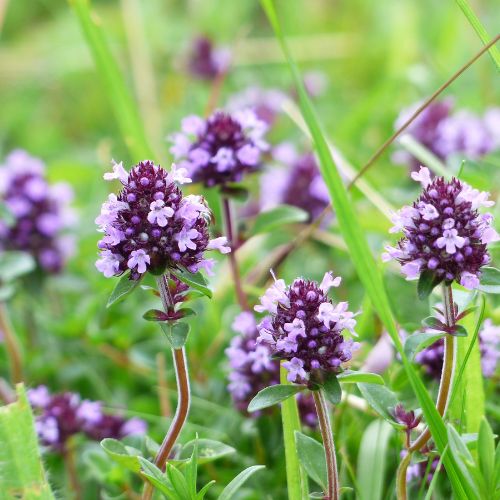Thyme, an aromatic herb that has captivated cooks, healers and gardeners for centuries, is much more than just a plant. With its intoxicating fragrance, distinctive flavor and medicinal properties, it has earned a special place in cooking, traditional medicine and the world of gardening.
Origin , characteristics and what thyme is used for.
Native to the Mediterranean region, thyme (Thymus vulgaris) has been an integral part of the cuisine and medicine of various cultures since ancient times. The ancient Egyptians used it in their embalming rituals, while the Greeks considered it a symbol of bravery and courage. In the Middle Ages, carrying a bouquet was believed to protect against evil forces.
Botanical characteristics
Thyme is a member of the Lamiaceae family, which includes mint, basil, and rosemary. It is a perennial plant that grows in low bushes with small, aromatic leaves. Its flowers, which can vary in color from white to lavender, attract bees, making it a valuable item for gardening enthusiasts.
Popular varieties
There are several varieties, each with its characteristic aroma and flavor. Lemon thyme provides a citrus touch, while orange thyme offers sweeter notes. Common thyme is the variety most used in cooking, but the diversity of options allows gardeners to experiment and find their favorite.
Culinary uses
It is a versatile ingredient in the kitchen, providing a touch of freshness and flavor to a variety of dishes. Its leaves can be used fresh or dried, and are commonly incorporated into stews, soups, sauces, and marinades. It is also a key component in herbal blends such as Provençal herbs, which enhance the flavor of Mediterranean dishes.
Medicinal properties
In addition to its role in cooking, it has been appreciated for its medicinal properties. It contains compounds such as thymol, known for its antibacterial and antifungal properties. Thyme infusions have been used to relieve coughs and colds, while its essential oil is used in aromatherapy to promote relaxation and relieve stress.
Cultivation, collection and care of thyme
Thyme is a hardy plant that thrives in well-drained soil and full sun. It can be grown in pots or in the garden, and its low maintenance makes it a popular choice for beginning gardeners. Pruning the plant regularly helps stimulate its growth and maintain its compact shape.
Harvesting thyme in Catalonia.
Catalonia, with its rich geographical and climatic diversity, is a paradise for lovers of nature and herbalism. Among the many gems that this region has to offer, thyme stands out as an aromatic and medicinal herb that grows wild in several places. Collecting thyme in Catalonia is an experience that combines the pleasure of exploring nature with the benefits of a versatile and aromatic plant.
Natural Parks and reserves
The natural parks and reserves of Catalonia are protected areas that are home to a great diversity of flora and fauna, including thyme. In places like the Montseny Natural Park or the Garrotxa Volcanic Zone Natural Park, it is possible to find fields and paths dotted with thyme. Be sure to follow local regulations and not disturb the natural balance when collecting.
mountain areas
The mountainous regions of Catalonia, such as the Pyrenees, are ideal habitats for thyme. Here, at different altitudes, you can discover unique varieties of this plant. Alpine meadows and sunny slopes often harbor thyme in abundance. Take walks in areas such as the Vall de Núria or the Cadí-Moixeró Natural Park to enjoy these beautiful areas and collect thyme sustainably.
fields and hills
In the rural areas and hills of Catalonia, especially in regions such as Empordà or the Penedès region, it is common to find fields dotted with thyme. The calcareous soils and Mediterranean climate create the perfect conditions for this plant to thrive. Ask locals about places where you can harvest ethically and sustainably.
Hiking trails
Catalonia has an extensive network of trails that wind through diverse landscapes. When walking routes such as the Cistercian Route or the Camino de Ronda, you are likely to find areas where thyme grows wild. Responsible harvesting is key, so be sure to follow local recommendations and don’t overpick.
Botanical Gardens
If you prefer to get to know thyme up close and you are in Barcelona, the botanical gardens of Catalonia are ideal places to learn about the diversity of thyme species. The Jardí Botànic of Barcelona or the Jardí Botànic of Cap Roig are examples where you can learn about thyme and its cultural and medicinal importance.


Leave a Reply